The perfect storm stalks Bolivia, the country most vulnerable to the climate crisis in South America
Seven departments in the country have already declared an emergency due to the lack of water. If the drought continues, cities like La Paz and El Alto will be left without water, while the inhabitants of rural areas will be forced to migrate to large cities
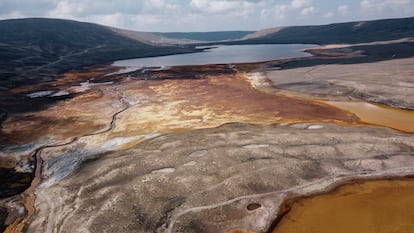
In Siete Lagunas, a community of Aymara origin at more than 4,000 meters above sea level in the Bolivian highlands, Erasmo Persona takes his llamas, alpacas, and cows to graze much higher because their usual pasture in the wetlands has dried up. Gabriel Pari, chief environmental officer of the Bolivian municipality of El Alto, despairs when he sees for himself that not a drop of water is flowing through the canal that connects the Janko Khota lake and the Milluni reservoir. The Milluni has a capacity of 10.8 million cubic meters and supplies the city of El Alto and part of La Paz. Now it has only 12% of the water it can hold, which is “unfortunately” tinged red and yellow by waste from the mining industry. Schoolgirl Luz Ferro is worried that the lack of water will force the Badajoz schools to close, as already happened during the 2016 drought and last October as a result of air pollution. And Juana, an environmental activist who prefers not to give her real name to avoid reprisals from loggers who are cutting down the Bolivian Amazon, laments the “fires” that are still active that “almost no one talks about” and points to deforestation as one of the main culprits of the drought that has afflicted Bolivia since 2022.
The testimonies of these four people give voice to the environmental catastrophe that Bolivia is suffering. Seven of the country’s nine departments have already declared an emergency due to drought, and wildfires have devastated almost three million hectares of the Bolivian Amazon (twice the area of Mexico City), according to the Ombudsman’s Office, and have left large blankets of smog that have reached the country’s large cities. Lake Titicaca, the highest navigable lake in the world, is at its lowest level since records began, and on November 15 historical records for maximum temperatures were broken in different places in the country, according to the National Meteorology and Hydrology Service. The prices of basics, such as potatoes and oca (Oxalis tuberosa), have tripled due to the drop in production caused by the scarcity of water.
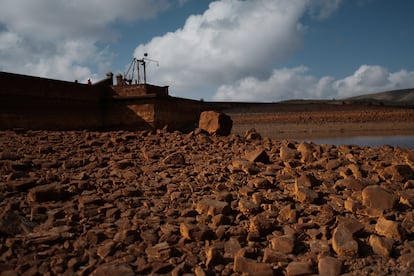
But in this country, the one that is most vulnerable to climate change in South America and the one that can be most affected by the lack of water on the entire continent — according to the Global Adaptation ranking by Notre Dame University in the United States — the situation will worsen with the arrival of El Niño, expected for early 2024. This cyclical phenomenon will result in a total absence of rain in the Bolivian highlands. And if there is still no rainfall before El Niño arrives, El Alto and La Paz, the second and third most populated cities in the country, respectively, will run out of water in February, according to the environmental management authorities in each city. The areas surrounding these cities, such as Siete Lagunas, will also suffer from shortages, which will force many among the rural population to migrate to cities that are already having difficulties providing sufficient resources to their inhabitants.
With the approach of the perfect storm that threatens to dry up Bolivia’s taps, political authorities, public and private institutions, and civil society are looking for solutions to solve supply problems and implement savings habits. In a land where the native peoples’ connection with nature is still palpable, some communities have even organized offerings and rituals to Pachamama (or Mother Earth), in the highest spots on the plateau to pray for an end to the drought. The goddess who is present in the imagination of the Andean peoples is formed by earth, water, fire, and air.
Land
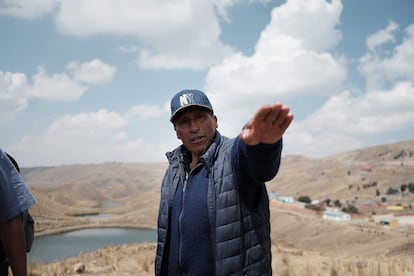
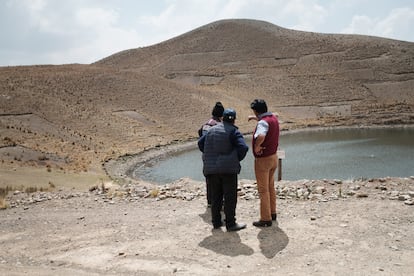
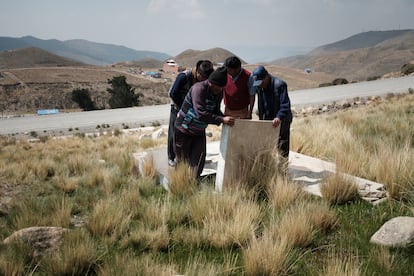
The lack of water is so evident in Siete Lagunas that two of the seven lakes that give it its name are completely dry. The tank where groundwater is stored is at its limit and literally only two droplets come out of the school tap that 52 children should use to wash their hands before starting classes. There is none, however, coming from the community kitchen tap.
Erasmo Persona does not want to leave the land — 13,750 feet above sea level —that “his parents and grandparents” left him, and where he has lived for the 57 years of his life. Although his weather-beaten face shows a more melancholic expression when he stamps his foot and raises dry moss with the tip of his boot. “Our little animals used to graze here, when there was no drought,” he says.
The earth that Persona has just removed was previously a wetland, a pasture with permanent moisture that was home to aquatic plants and which spread across the plateau before the drought. But it’s getting harder and harder to find them. David Poma, the jilakata, or head of Siete Lagunas community, laments that they have lost approximately “30% of the cattle” and that the ones that remain “are much skinnier,” because the lack of water influences the quality and quantity of the plants they ingest. “People don’t want to buy them from us,” he says. And although there are still enough animals for the 96 families that live in the community to be self-sufficient, the collapse in meat sales has caused them a significant loss of income.

The drought has also affected crops. “Without rain, the potatoes take a while to come out and there are fewer of them and they are smaller,” Poma complains. But they can also now cultivate less land, Persona adds: “The land here is very rocky and it slopes, so if there is no water, the soil is too hard” to cultivate. Because their methods are still traditional: “Fallow, hoe, and prepare the land with our sheep manure,” describes the community member. A “great effort” in a place where the altitude empties the lungs of oxygen.
The drop in potato production in Bolivia — it is the third-largest potato producer in South America after Colombia and Chile, according to the FAO (the U.N. Food and Agriculture Organization) — is widespread. “The drought has caused a shortage of potatoes, which has in turn led to an increase in the prices for families buying basic products that come from the Altiplano, which include not only potatoes, but also oca, beans, and corn,” explains Roberto Rojas. The environmental expert is with Educo, an NGO that works in the area with educational programs on many topics including water saving. “Traditionally, the arroba [12.68 tons] of potatoes cost about 40 or 50 bolivianos [between $5.84 and $7.30], but since last year it has risen to 100 or 130 [between $14.60 and $18.98],” he adds. For this reason, he continues, “many of the producing families in the Altiplano have had to change their crop.”
Poma acknowledges that many young people “think about going to the city.” However, the jilakata is seeking alternatives to guarantee the survival of his people. “We have bought high quality seeds for this season because last year we were not able to obtain them from our harvest, but we are also depending on good weather, on rain,” he explains. The other means of subsistence, Poma claims, involves new pipelines to extract underground water. “We would only need financing to buy the materials, because we already have the labor in the community,” he say. Persona nods: “We all help each other here. It is our land.”
Water
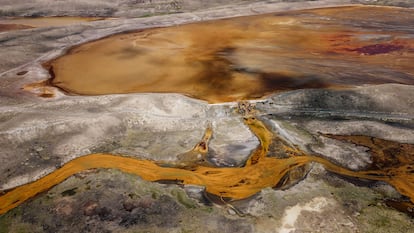



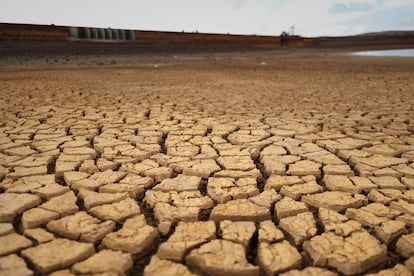
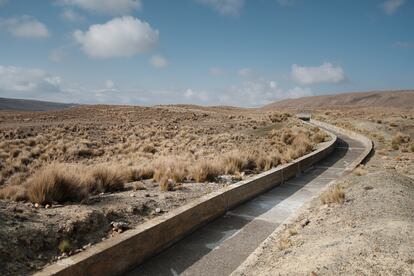
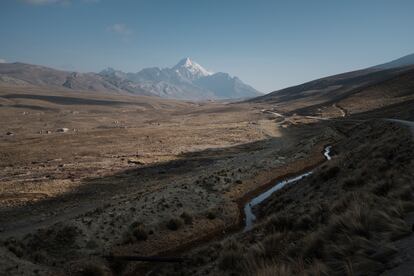
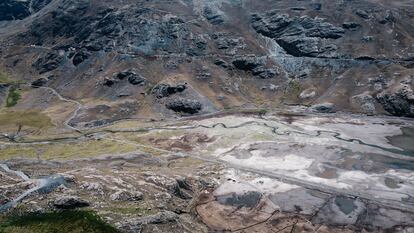
Hardly any water flows through the canal that connects the Milluni reservoir with the Alto Lima treatment plant. The llamas and alpacas in the area used to drink from that orange thread, a mixture of mining waste of iron, sulfur, copper, and tin. “The community members no longer let them drink there because the animals got sick with diarrhea and died,” explains Roberto Rojas. It is the same water they drink in El Alto and part of La Paz after it passes through purification facilities.
Gabriel Pari, chief environmental officer in El Alto, climbs to 14,760 feet above sea level, wearing mountain clothing and a white helmet, to check the state of the Milluni reservoir in person. It bothers him to verify that not a single drop of water is flowing through the channel that connects Milluni to the Janko Khota lake and immediately calls someone from EPSAS (Public and Social Water and Sanitation Company of Bolivia), the state manager of these reservoirs, to find out what is happening. He believes it is a “maintenance operation” to prevent the pipes from losing water. Because Milluni, which is at 12% of its capacity, according to the latest data available to Pari, cannot afford a single leak. According to an EPSAS study, 27% of the water that is cleaned in the treatment plant before reaching El Alto is lost due to the state of the pipes.
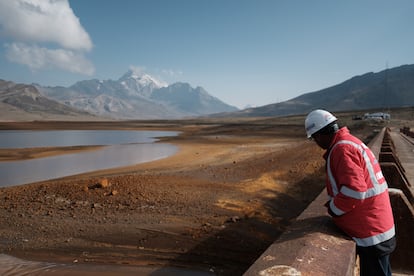
Janko Khota water is not only essential to guarantee the supply, but also to “reduce” the concentration of heavy metal waste from the mining settlements around Milluni — totaling 21 legal mines and countless illegal pits — which basically extract iron, sulfur, copper, and zinc, Pari explains. Rojas recalls that mining “is Bolivia’s second source of income” — the first is gas — and although “environmental regulations require that every concession addresses environmental liabilities, there are so few officials in Bolivia that it is not possible to carry out inspections of all the mining companies in the country,” he laments. The colors of the land that surrounds Milluni are precisely due to mining extraction processes, a torn, lunar landscape with red, yellow, and orange tones.
The panoramic view of the environmental disaster is completed in the background by Mount Huayna Potosí, rising to 19,980 feet. The retreat of the snow toward the summit is evident. “This year there has been almost no snow,” says Pari, which, added to the increase in temperatures, has also changed the hue of the peak: “It has gone from white to brown, because the ice layer is so thin that you can see the rock,” he explains. Although thaws only contribute to between 15% and 25% of the capacity of the reservoirs, depending on their location, “everything adds up.” For this reason, the retreat of snowfall “also affects the lack of water.”
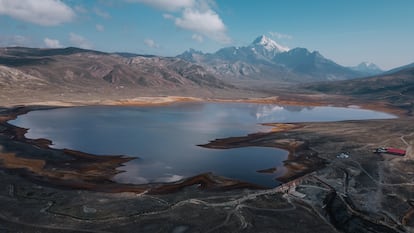
“Climate change is causing the weather to be less cloudy. That’s something that very directly affects this area of the planet because when there are fewer clouds, temperatures increase and more water evaporates,” explains Rojas. This is what has happened at the Incachaca reservoir, also surrounded by mining settlements and at 40% of its capacity. And it is the same effect that is occurring in Lake Titicaca, “which is evaporating,” he regrets. If no remedy is found, the same “future as Lake Poopó” awaits, the environmental expert adds. The lake was the second largest in the country and has now become dry land.
The Government of President Luis Arce implemented the Water to Live Well program in 2020, with an investment of 8.2 billion bolivianos (about $1.2 billion) to carry out “water, irrigation, and sanitation projects” in the following three years in both the cities as well as in rural areas, as announced last September by the Minister of Environment and Water Rubén Méndez. Since then, 41 dams and irrigation systems have been built and 3,353 projects related to water and sanitation have been put into action.
However, more than infrastructure, water scarcity is “a climate change issue,” says Eduardo Galindo, the municipal Secretary of Environmental Management and Renewable Energies, who recalls that “85% of the water in La Paz comes from rain.” For this reason, the authorities insist on the need to adopt water-saving habits. According to Galindo, the capital’s municipal government is finalizing a rule so that “all five-story buildings have a small treatment plant” to recycle water from washing machines or showers and then pump it to the toilets. But there are many other measures that can be adopted, such as stopping watering plants or washing cars with drinking water, says Pari.
Fire
The Madidi National Park in Bolivia is the place with the greatest tree diversity in the world, and it was here that a research team that included Juana came to “count 43 varieties of ants” that lived in one tree. She prefers not to reveal her real name for fear that her involvement in the fight for the environment would lead to security problems with loggers. Juana mentions the ants in a telephone conversation to highlight the calamity that fires represent in the protected area. While she chats with this newspaper, the smoke from the flames that are destroying the forests hundreds of miles from La Paz is giving the capital’s sky a light gray tint.
“Bolivian forests are suffering from huge deforestation,” says Roberto Rojas from the NGO Educo. According to the expert, the reasons are twofold. Firstly, “the expansion of the agricultural frontier, to plant soybeans or sunflowers, and coca too,” he explains. And this last crop, “which is now harvested up to five times a year, twice more than before due to the implementation of irrigation systems,” is extremely “expensive.” Secondly, because of gold mining, which also uses mercury to separate the precious metal from other minerals. It is “a very toxic substance that contaminates water and all biodiversity.” Juana points out a third reason, which is directly linked to the commercialization of wood. After the drop in natural gas production — exports have fallen by 33%, as the Bolivian government has admitted — the activist believes that loggers are seeking economic profit in the mountains. “But they don’t see the real value of a tree. They calculate how much 6,000 feet of wood is worth, and they sell it for a pittance.”
According to Leila Solís, an environmental technician at Educo, the thinner vegetation cover caused by the felling and burning of forests is one of the reasons for the lower number of clouds that sets the wheel of drought in motion: “The fewer clouds, the greater the radiation, and the quicker the water evaporates.”
The Bolivian government maintains that the fires, which have been burning almost continuously for the last five months, “are under control.” But new images of fires arrive daily on Juana’s cell phone — the environmentalist can no longer travel to the jungle after an alligator “took a piece of her leg.” “I worked with the people from that land for years, and now they remember me and send me proof of what is happening there,” she says. The Bolivian Ombudsman’s Office has put figures to the catastrophe that Juana describes: so far in 2023, almost three million hectares of the Bolivian Amazon have burned.
Air

The smoke from the fires that are ravaging Bolivia forced the closure of schools in La Paz and Santa Cruz at the end of October due to poor air quality. A look at the sky over the capital, a month later, reveals that the smoke has not completely disappeared and that it returns intermittently. The danger of school closures has not dissipated, either. If not because of pollution, schools could close due to lack of water, under a measure that was already adopted during the drought that hit the country in 2016. Schools closed due to the impossibility of keeping bathrooms and hygiene facilities in operation.
“We have few rivers and the few that remain are polluted,” explains Nelson Cáceres, a 4th grade teacher at the J. F. Kennedy Educational Unit, in La Paz. “You can see the pollution in Achachicala, near here, because there are factories that throw their liquid waste into the river,” he complains. The kids “worry” and even “cry about the situation.”
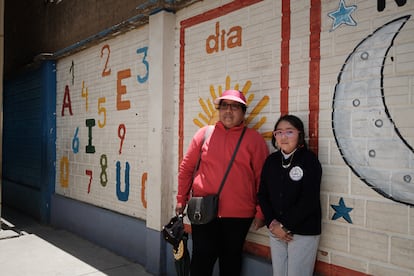
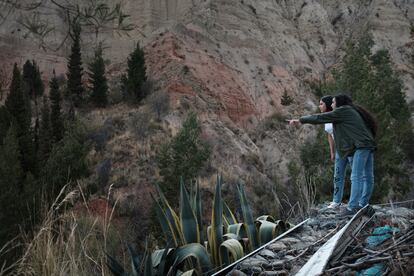
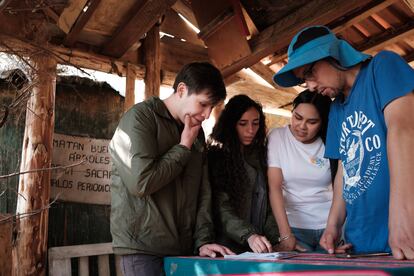
Luz Ferro, a ten-year-old student at the school, is one of the girls who are worried about pollution. “Those who toss this garbage in the river have no heart,” she says. But she does not cry and prefers to get involved in protecting the environment. She is especially concerned about the lack of water — “without it, it is impossible to live,” she says — and she participates in an Educo program focused on children as a driver of change to raise awareness about using water sparingly and the need to recycle it. “You can keep it in buckets and reuse it later for bathing, cleaning, or watering,” she tells us. It is information that she shares with her family, as her mother confirms.
The young environmentalists at Propacha, an organization based in La Paz, have professionalized their climate activism with tangible measures to safeguard and restore the environment. They prefer action to crying. “Our goal is to raise awareness through example: if a person needs 22 trees to breathe, we are going to be the first to plant our 22 trees, to demonstrate that power is a matter of wanting,” explains Cristian Iturralde Aparicio, a member of the organization.
The protected area of Bolognia Park, in the heart of the capital, is an example of how to rehabilitate a degraded area, with “rewilding” using native species. Among the trees, you don’t feel the pollution that prevails in the city center. But Propacha is also committed to innovative projects, such as “the first technological educational garden.” “The idea is for it to be managed from a cell phone to involve children by changing the paradigm of how we teach agriculture,” says Guillermo Mallea, the movement’s co-founder. And he adds: “Agriculture is a very hard job that is often romanticized, and here, instead of taking care of the plant as such, we teach people how to maintain the system that takes care of the plant.”
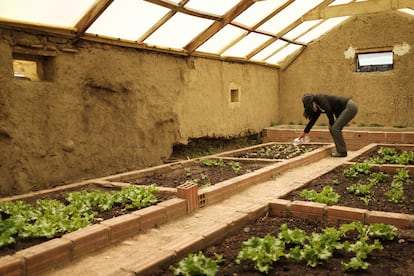
About twenty kilometers away, after crossing a stretch of the city and traveling along a rocky mountain road that takes about an hour by car, we meet Evelyn. She is one of the three teachers at the Siete Lagunas school. She enters the greenhouse that the school has just finished renovating with a bottle in her hand to water the lettuce that her class has planted. Using a mobile app is not possible in the Andean community where water barely reaches the school. But the philosophy is the same. In addition to vegetables, each child has planted queñua (Polylepis rugulosa) and kiswara (Buddleja incana) trees that are native to the region next to the playground. The young teacher smiles: “When there is no water to irrigate the plants, the children bring their own bottles from home, because if they are responsibile for a tree, they will be responsible for their entire life.”
Sign up for our weekly newsletter to get more English-language news coverage from EL PAÍS USA Edition
Tu suscripción se está usando en otro dispositivo
¿Quieres añadir otro usuario a tu suscripción?
Si continúas leyendo en este dispositivo, no se podrá leer en el otro.
FlechaTu suscripción se está usando en otro dispositivo y solo puedes acceder a EL PAÍS desde un dispositivo a la vez.
Si quieres compartir tu cuenta, cambia tu suscripción a la modalidad Premium, así podrás añadir otro usuario. Cada uno accederá con su propia cuenta de email, lo que os permitirá personalizar vuestra experiencia en EL PAÍS.
¿Tienes una suscripción de empresa? Accede aquí para contratar más cuentas.
En el caso de no saber quién está usando tu cuenta, te recomendamos cambiar tu contraseña aquí.
Si decides continuar compartiendo tu cuenta, este mensaje se mostrará en tu dispositivo y en el de la otra persona que está usando tu cuenta de forma indefinida, afectando a tu experiencia de lectura. Puedes consultar aquí los términos y condiciones de la suscripción digital.
More information
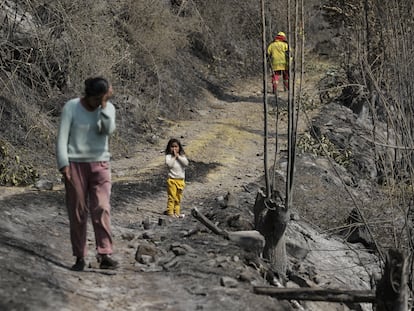
Amid a severe drought, slash-and-burn fuels controversy in Bolivia
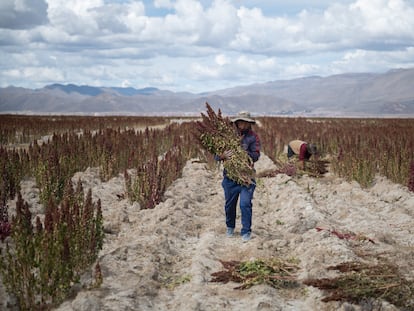
Severe drought parches Bolivia: ‘My biggest fear is running out of food and water’
Archived In
Últimas noticias
Most viewed
- Sinaloa Cartel war is taking its toll on Los Chapitos
- Reinhard Genzel, Nobel laureate in physics: ‘One-minute videos will never give you the truth’
- Oona Chaplin: ‘I told James Cameron that I was living in a treehouse and starting a permaculture project with a friend’
- Why the price of coffee has skyrocketed: from Brazilian plantations to specialty coffee houses
- David King, chemist: ‘There are scientists studying how to cool the planet; nobody should stop these experiments from happening’








































